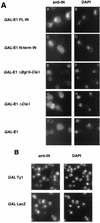Invading the yeast nucleus: a nuclear localization signal at the C terminus of Ty1 integrase is required for transposition in vivo
- PMID: 9448009
- PMCID: PMC108824
- DOI: 10.1128/MCB.18.2.1115
Invading the yeast nucleus: a nuclear localization signal at the C terminus of Ty1 integrase is required for transposition in vivo
Abstract
Retrotransposon Ty1 faces a formidable cell barrier during transposition--the yeast nuclear membrane which remains intact throughout the cell cycle. We investigated the mechanism by which transposition intermediates are transported from the cytoplasm (the presumed site of Ty1 DNA synthesis) to the nucleus, where they are integrated into the genome. Ty1 integrase has a nuclear localization signal (NLS) at its C terminus. Both full-length integrase and a C-terminal fragment localize to the nucleus. C-terminal deletion mutants in Ty1 integrase were used to map the putative NLS to the last 74 amino acid residues of integrase. Mutations in basic segments within this region decreased retrotransposition at least 50-fold in vivo. Furthermore, these mutant integrase proteins failed to localize to the nucleus. Production of virus-like particles, reverse transcriptase activity, and complete in vitro Ty1 integration resembled wild-type levels, consistent with failure of the mutant integrases to enter the nucleus.
Figures





Similar articles
-
A Ty1 integrase nuclear localization signal required for retrotransposition.Mol Cell Biol. 1998 Feb;18(2):1105-14. doi: 10.1128/MCB.18.2.1105. Mol Cell Biol. 1998. PMID: 9448008 Free PMC article.
-
The Ty1 integrase protein can exploit the classical nuclear protein import machinery for entry into the nucleus.Nucleic Acids Res. 2008 Aug;36(13):4317-26. doi: 10.1093/nar/gkn383. Epub 2008 Jun 27. Nucleic Acids Res. 2008. PMID: 18586821 Free PMC article.
-
Nuclear import of the retrotransposon Tf1 is governed by a nuclear localization signal that possesses a unique requirement for the FXFG nuclear pore factor Nup124p.Mol Cell Biol. 2000 Oct;20(20):7798-812. doi: 10.1128/MCB.20.20.7798-7812.2000. Mol Cell Biol. 2000. PMID: 11003674 Free PMC article.
-
Ty1 integrase overexpression leads to integration of non-Ty1 DNA fragments into the genome of Saccharomyces cerevisiae.Mol Genet Genomics. 2010 Oct;284(4):231-42. doi: 10.1007/s00438-010-0561-4. Epub 2010 Jul 31. Mol Genet Genomics. 2010. PMID: 20677012 Free PMC article. Review.
-
Reverse transcriptase and integrase of the Saccharomyces cerevisiae Ty1 element.Cytogenet Genome Res. 2005;110(1-4):269-87. doi: 10.1159/000084960. Cytogenet Genome Res. 2005. PMID: 16093680 Review.
Cited by
-
Retrotransposon suicide: formation of Ty1 circles and autointegration via a central DNA flap.J Virol. 2006 Dec;80(24):11920-34. doi: 10.1128/JVI.01483-06. Epub 2006 Sep 27. J Virol. 2006. PMID: 17005648 Free PMC article.
-
Viral Appropriation: Laying Claim to Host Nuclear Transport Machinery.Cells. 2019 Jun 8;8(6):559. doi: 10.3390/cells8060559. Cells. 2019. PMID: 31181773 Free PMC article. Review.
-
Diverse transposable element landscapes in pathogenic and nonpathogenic yeast models: the value of a comparative perspective.Mob DNA. 2020 Apr 21;11:16. doi: 10.1186/s13100-020-00215-x. eCollection 2020. Mob DNA. 2020. PMID: 32336995 Free PMC article. Review.
-
Functional analysis of N-terminal residues of ty1 integrase.J Virol. 2009 Sep;83(18):9502-11. doi: 10.1128/JVI.00159-09. Epub 2009 Jul 1. J Virol. 2009. PMID: 19570857 Free PMC article.
-
NORF5/HUG1 is a component of the MEC1-mediated checkpoint response to DNA damage and replication arrest in Saccharomyces cerevisiae.Mol Cell Biol. 1999 Oct;19(10):7041-9. doi: 10.1128/MCB.19.10.7041. Mol Cell Biol. 1999. PMID: 10490641 Free PMC article.
References
-
- Adams A E, Pringle J R. Staining of actin with fluorochrome-conjugated phalloidin. Methods Enzymol. 1991;194:729–731. - PubMed
-
- Aitchison J D, Rout M P, Marelli M, Blobel G, Wozniak R W. Two novel related yeast nucleoporins, Nup170p and Nup157p: complementation with the vertebrate homologue Nup155p and functional interactions with the yeast nuclear pore-membrane protein Pom152p. J Cell Biol. 1995;131:1133–1148. - PMC - PubMed
-
- Bassett, D. Personal communication.
Publication types
MeSH terms
Substances
Grants and funding
LinkOut - more resources
Full Text Sources
Other Literature Sources
Molecular Biology Databases
